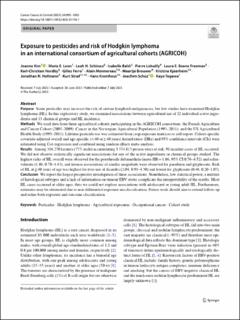| dc.contributor.author | Kim, Joanne | |
| dc.contributor.author | Leon, Maria E. | |
| dc.contributor.author | Schinasi, Leah H. | |
| dc.contributor.author | Baldi, Isabelle | |
| dc.contributor.author | Lebailly, Pierre | |
| dc.contributor.author | Freeman, Laura E Beane | |
| dc.contributor.author | Nordby, Karl-Christian | |
| dc.contributor.author | Ferro, Gilles | |
| dc.contributor.author | Monnereau, Alain | |
| dc.contributor.author | Brouwer, Maartje | |
| dc.contributor.author | Kjærheim, Kristina | |
| dc.contributor.author | Hofmann, Jonathan N. | |
| dc.contributor.author | Straif, Kurt | |
| dc.contributor.author | Kromhout, Hans | |
| dc.contributor.author | Schüz, Joachim | |
| dc.contributor.author | Togawa, Kayo | |
| dc.date.accessioned | 2024-02-20T09:17:38Z | |
| dc.date.available | 2024-02-20T09:17:38Z | |
| dc.date.created | 2023-07-17T11:16:12Z | |
| dc.date.issued | 2023 | |
| dc.identifier.citation | Cancer Causes and Control. 2023, 34 995-1003. | |
| dc.identifier.issn | 0957-5243 | |
| dc.identifier.uri | https://hdl.handle.net/11250/3118591 | |
| dc.description.abstract | Purpose: Some pesticides may increase the risk of certain lymphoid malignancies, but few studies have examined Hodgkin lymphoma (HL). In this exploratory study, we examined associations between agricultural use of 22 individual active ingredients and 13 chemical groups and HL incidence. Methods: We used data from three agricultural cohorts participating in the AGRICOH consortium: the French Agriculture and Cancer Cohort (2005-2009), Cancer in the Norwegian Agricultural Population (1993-2011), and the US Agricultural Health Study (1993-2011). Lifetime pesticide use was estimated from crop-exposure matrices or self-report. Cohort-specific covariate-adjusted overall and age-specific (< 40 or ≥ 40 years) hazard ratios (HRs) and 95% confidence intervals (CIs) were estimated using Cox regression and combined using random effects meta-analysis. Results: Among 316 270 farmers (75% male) accumulating 3 574 815 person-years at risk, 91 incident cases of HL occurred. We did not observe statistically significant associations for any of the active ingredients or chemical groups studied. The highest risks of HL overall were observed for the pyrethroids deltamethrin (meta-HR = 1.86, 95% CI 0.76-4.52) and esfenvalerate (1.86, 0.78-4.43), and inverse associations of similar magnitude were observed for parathion and glyphosate. Risk of HL at ≥ 40 years of age was highest for ever-use of dicamba (2.04, 0.93-4.50) and lowest for glyphosate (0.46, 0.20-1.07). Conclusion: We report the largest prospective investigation of these associations. Nonetheless, low statistical power, a mixture of histological subtypes and a lack of information on tumour EBV status complicate the interpretability of the results. Most HL cases occurred at older ages, thus we could not explore associations with adolescent or young adult HL. Furthermore, estimates may be attenuated due to non-differential exposure misclassification. Future work should aim to extend follow-up and refine both exposure and outcome classification. | |
| dc.description.abstract | Exposure to pesticides and risk of Hodgkin lymphoma in an international consortium of agricultural cohorts (AGRICOH) | |
| dc.language.iso | eng | |
| dc.title | Exposure to pesticides and risk of Hodgkin lymphoma in an international consortium of agricultural cohorts (AGRICOH) | |
| dc.title.alternative | Exposure to pesticides and risk of Hodgkin lymphoma in an international consortium of agricultural cohorts (AGRICOH) | |
| dc.type | Peer reviewed | |
| dc.type | Journal article | |
| dc.description.version | publishedVersion | |
| dc.source.pagenumber | 995-1003 | |
| dc.source.volume | 34 | |
| dc.source.journal | Cancer Causes and Control | |
| dc.identifier.doi | 10.1007/s10552-023-01748-1 | |
| dc.identifier.cristin | 2162472 | |
| cristin.ispublished | true | |
| cristin.fulltext | original | |
| cristin.qualitycode | 1 | |
